How to Pick a Great Soup Pot
Choosing the right soup pot makes cooking easier and more enjoyable. A good pot helps your soup cook evenly and prevents burning.
It holds the perfect amount for your family, whether you’re making a small batch or a big one. There are lots of options out there—different sizes, materials, and shapes. But don’t worry, you don’t have to be an expert to find the right one.
In this post, I’ll walk you through what to look for when buying a soup pot. We’ll cover the important stuff like size, material, heat distribution, and handles.
I’ll explain why these things matter and how they affect your cooking. Whether you’re simmering a classic chicken noodle or experimenting with a spicy chili, having the right pot makes a big difference.
You’ll learn how to pick a pot that fits your needs and your kitchen. Plus, I’ll share tips on what to avoid so you don’t waste money on pots that don’t work well.
By the end, you’ll feel confident shopping for a soup pot that will become your new favorite kitchen tool. Let’s dive in and find the perfect pot for your next delicious batch of soup!
What to look for in a good soup pot?
Quality | Description | Why It Matters |
| Material | Stainless steel, enameled cast iron, copper, or aluminum with non-reactive lining | Impacts heat conductivity, durability, reactivity with acidic foods, and ease of cleaning |
| Size/Capacity | Ranges from 4 to 12+ quarts depending on household size and batch cooking | Determines how much soup you can make—larger pots are great for stocks, batch cooking, or entertaining |
| Weight | Heavier pots (like cast iron or multi-ply stainless) vs. lighter aluminum | Heavy pots retain heat better; lighter ones are easier to handle and store |
| Base Thickness | Thick, layered base (often aluminum core in stainless) | Promotes even heating and prevents scorching at the bottom |
| Handles | Large, sturdy, riveted or welded handles | Important for safe lifting, especially when full; should be heat-resistant or oven-safe if needed |
| Lid Fit | Tight-fitting lid made of same material or tempered glass | Helps retain moisture and heat, especially for long simmers |
| Interior Finish | Smooth, non-reactive finish—polished stainless or enameled | Prevents sticking and makes for easy cleaning and monitoring browning |
| Oven-Safe Temperature | Range of oven safety (typically 350°F to 500°F) | Adds versatility for finishing soups or braises in the oven |
| Ease of Cleaning | Dishwasher-safe or easy to clean by hand | Reduces maintenance hassle; enameled interiors or polished stainless are best |
| Compatibility | Induction-compatible base if using an induction cooktop | Expands usability on all cooktops—gas, electric, induction |
| Shape & Design | Taller sides with a wider base | Helps reduce evaporation while giving enough surface for sautéing ingredients |
| Pouring Lip or Spout | Some pots include a slight lip or spout for pouring | Makes transferring soup or broth cleaner and easier |
| Reputable Brand/Warranty | Backed by a trusted brand with a good warranty | Ensures long-term durability and support in case of defects or issues |
Size
Soup pots usually range in size from about 4 quarts up to 20 quarts, before you reach commercial sizes. While a soup pot doesn’t need to be as large as a stock pot—since soup batches are often smaller—you also don’t need separate pots for soup and stock.
I recommend choosing a pot between 6 and 12 quarts. This size offers plenty of versatility for making soups as well as other cooking tasks.
Shape
A soup pot typically has a round base, deep straight sides, and a lid. While this shape is especially useful for making stocks and reducing liquids, it works great for soups as well.
Can you use a shorter, wider pan for soup instead? Definitely—depending on the amount you’re cooking, a large saucepan might be a good choice
Structure
No matter what type of pan you choose, it should have a thick, heavy bottom to prevent burning—this is especially important for soup pots. Since soups often simmer for long periods, the pot will be sitting on the stove for a while. A thin or cheaply made bottom can cause ingredients to scorch and stick, ruining the flavor and making cleanup harder.
Materials
There are many opinions on the best material for cookware. For a deeper dive, check out my post on How to Choose the Right Cookware.
In that article, you’ll learn about options like copper, aluminum, cast iron, stainless steel, nonstick, and multi-material combinations. Each material has its own advantages, drawbacks, and price points.
For example, brands like Calphalon use “hard-anodized” aluminum—an electrochemical process originally developed by NASA for aerospace—that produces cookware harder than stainless steel and non-reactive to acids. It’s like cooking with a futuristic pot, George Jetson style!
With so many choices, your decision will come down to availability, budget, and what feels comfortable in your hand.
Conductivity
This refers to how well the pot transfers heat from the stove to your food, and how evenly it distributes that heat. A well-made soup pot heats evenly across the bottom and up the sides, ensuring your soup cooks consistently from top to bottom.
Since different metals conduct heat in different ways, choosing the right material and construction is key to matching your cooking style and stove type.
Handles
Whether you’re simmering soup or boiling corn, you want a sturdy pot with handles that feel secure and won’t loosen when lifting a full, hot pot.
Look for pots with handles attached by heavy-duty screws or rivets for extra durability.
Many newer pots have handles designed to stay cooler on the stovetop, which is handy when moving the pot around. But remember, “cool-resistant” doesn’t mean “oven-proof.” Always use silicone mitts when removing cookware from a hot oven.
Also consider the handle’s shape and size—it should allow a comfortable, safe grip even when using potholders.
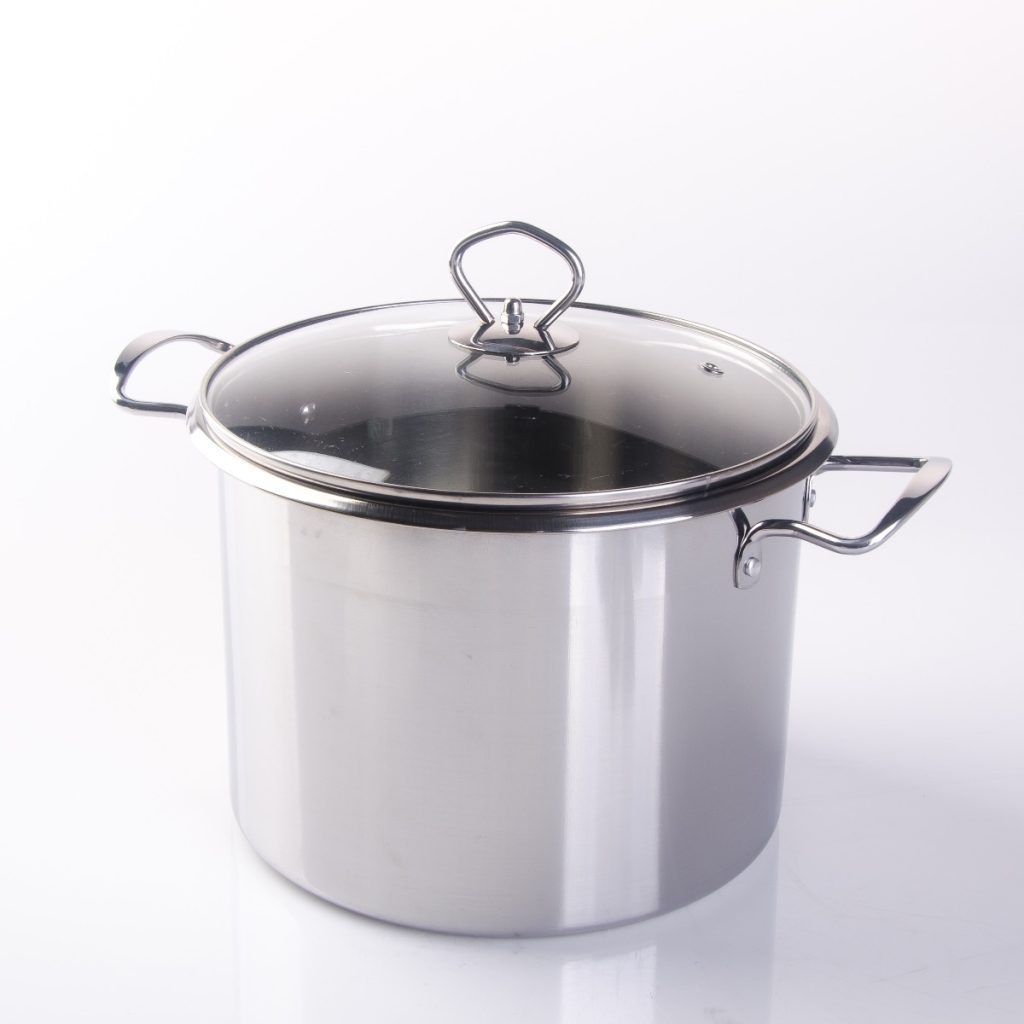
onlinesources: Soup Pots
There are lots of sources for purchasing a quality soup pot, and I suggest you check out your local department stores and kitchen supply shops to find one that’s right for you. You want to feel it in your hands and check the weight, size, and materials. If you’re looking for a wide selection of products and prices, you may want to check out some online sources for ideas, prices, and maybe even a place to purchase your goods.

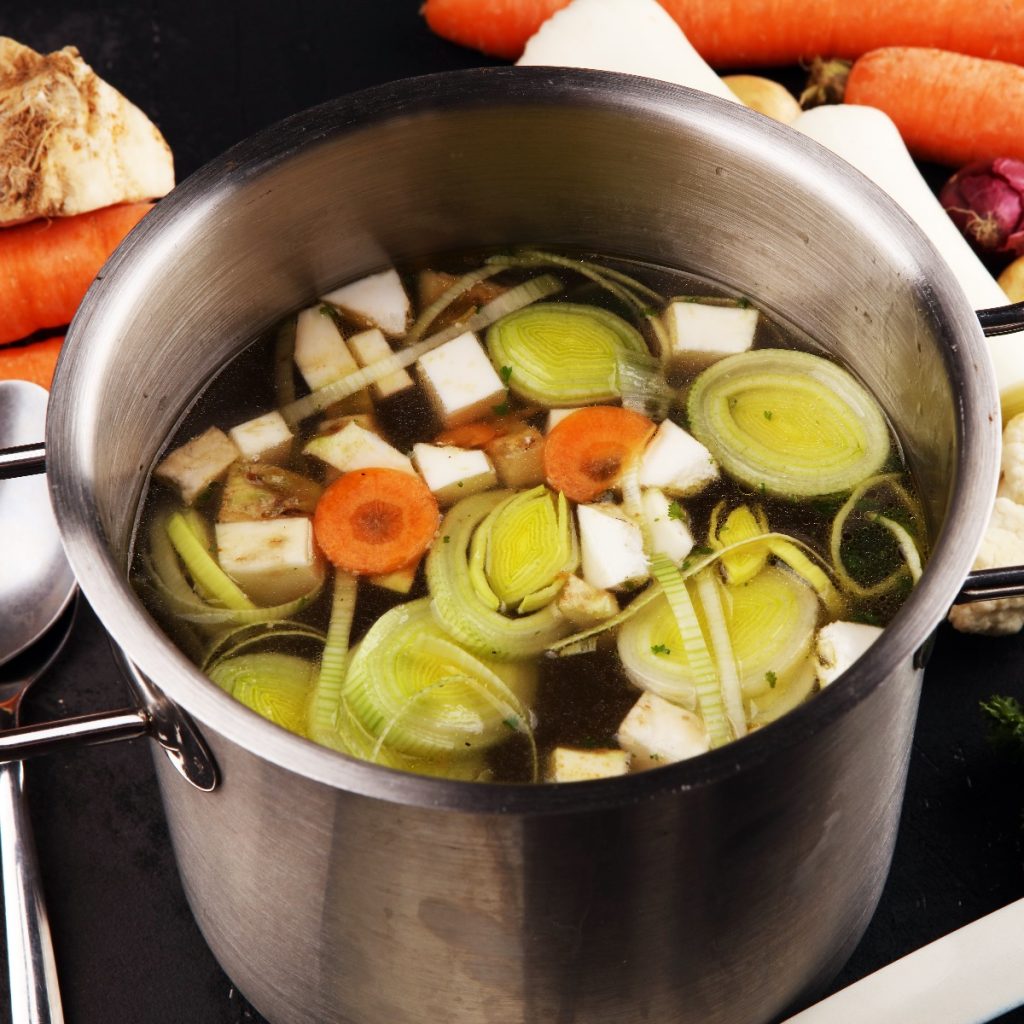
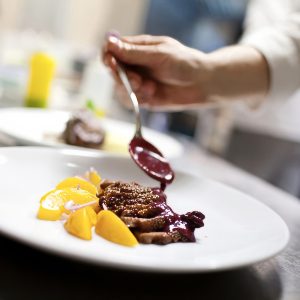

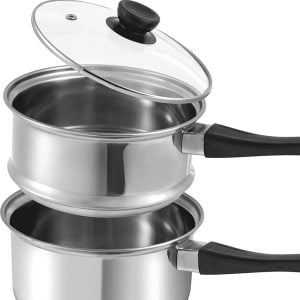
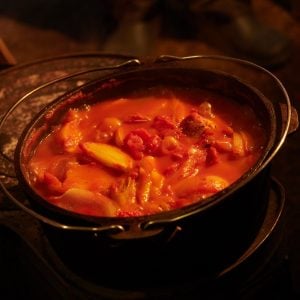

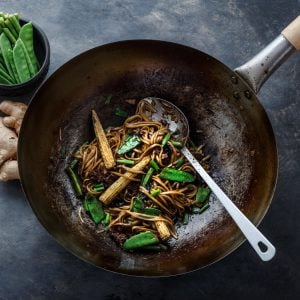
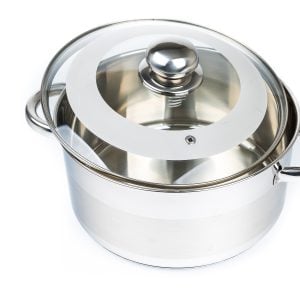
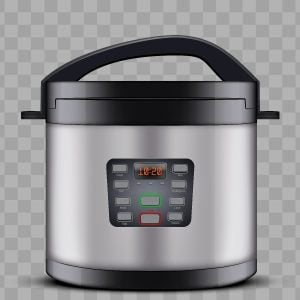
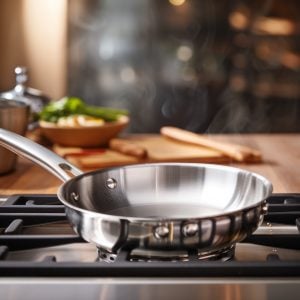


11 Responses
I became really annoyed with this piece when I realized you didn’t link the article you suggest in the following sentence (never mind the grammar): “For a good article on cookware material from a professional chef, check out contributing chef Mark Vogel’s, How to Choose Cookware.”
Hi Andrea, please do not be annoyed. My site is the hobby of one and has changed from html to Joomla and now to WordPress. Each time the site gets switched, links are lost and pages missing. Just seems to happen. I appreciate your letting me know and I will fix the link and the grammar too. I also appreciate help from my visitors letting me know when I’ve made mistakes and sorry to cause you any annoyance.
This is unnecessarily aggressive lol
Thanks for the article, I’m looking for a pot for my daughter’s house warming gift. Can’t decide between s.s. or enameled cast iron. Also, I’m sorry for the earlier comment from the annoyed woman, doesn’t take much to set some people off, esp. if they have mental issues. You seemed to take it seriously and owe no one an apology.
Hi Wendy, thanks for your comments. Is there any way you can get some ideas from your daughter without letting on your motives? If you just happen to be in a cookware store, maybe you can look at some different brands and get her opinion. I love the enameled cast iron. Besides being great to cook in, they look great too but they are heavy.
I would like to know where I can purchase a soup pot that is the heavy duty stainless steel rthat flares out from the base allowing the movement of the vegetables/beans/pasta/rice/meat to be in a continuous rolling motion that prevents scorching and running of the solids. I had seen this pot/pan a number of years ago but the company went out of business. Thank you. Sincerely, Nancy
Made In 8‑Qt 5‑Ply Stainless Clad Stock Pot
5-ply construction all the way through—aluminum core sandwiched by stainless steel—ensures super-even heat from the bottom up. Highly praised by Bon Appétit and Food & Wine for its wide, squat shape that promotes a gentle “rolling boil” perfect for soups and chowders
All‑Clad™ Stainless Steel Stockpot
Fully-clad stainless construction, flared sides and rim for drip-free pouring, double-riveted handles, oven-safe to 600 °F. Celebrated by Bon Appétit for even heating and wide profile ideal for searing and simmering in the same pot
bonappetit.com
HexClad 8‑Qt Hybrid Stock Pot
Hybrid stainless/aluminum design with nonstick durability and easy cleanup, built to handle soups, stews, and pasta with smooth release and even heat.
Well, this is ridiculous ! I have spent twenty minutes trying to find a place to order a soup. Twenty minutes. All I get is a picture of a red soup pot and the article. No matter what I place in the search box, all I get is a picture of a red soup pot and the article.
Twenty minutes I spent running around your website. I have been shopping on line for 10 years. Is it me or your website???
Hi Marilyn, not sure what you are looking for but this post is to learn more about soup pots so you can go out to your favorite cookware store or online shop to purchase one. I don’t sell any from my site. Sorry for the confusion.
I would like to know which type of pot is best for making cream or milk based soups like New England Clam Chowder. Something that is least likely to burn the product even with frequent stirring
Hi JoAnna, For cream- or milk-based soups like New England Clam Chowder, a heavy-bottomed stainless steel pot is your best bet. Here’s why:
Even Heat Distribution: Stainless steel pots with a thick, layered (often aluminum-core) base prevent hot spots, so your creamy soup won’t scorch or stick on the bottom.
Non-Reactive Surface: Unlike aluminum or copper alone, stainless steel won’t react with dairy or acidic ingredients, keeping the flavor pure and preventing discoloration.
Easy to Stir: The smooth interior surface makes stirring cream soups easier, helping to prevent curdling or burning.
Durability and Versatility: Stainless steel pots are durable, dishwasher-safe, and can be used from stove to oven if your recipe calls for finishing in the oven.
Avoid pots made solely of aluminum or cast iron for cream soups, as they can cause the dairy to react or burn more easily.
If you prefer nonstick, choose a high-quality one with a heavy base; however, stainless steel is generally the safest and most reliable choice for silky smooth chowders.